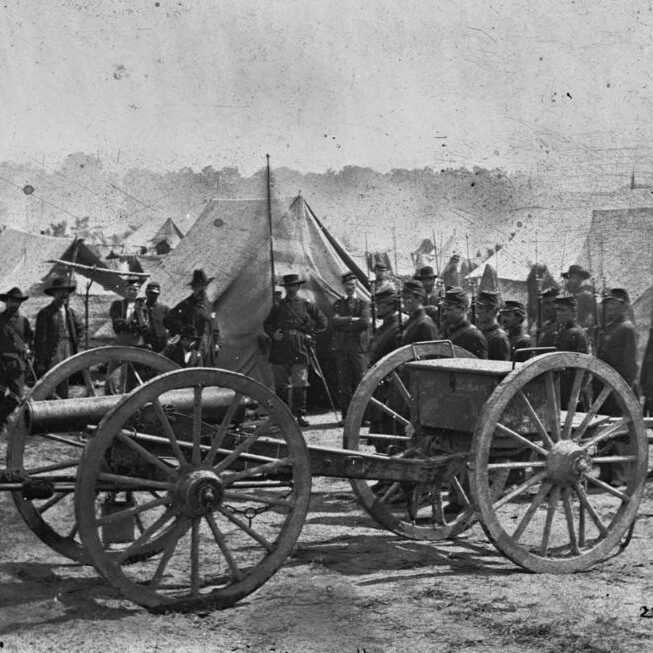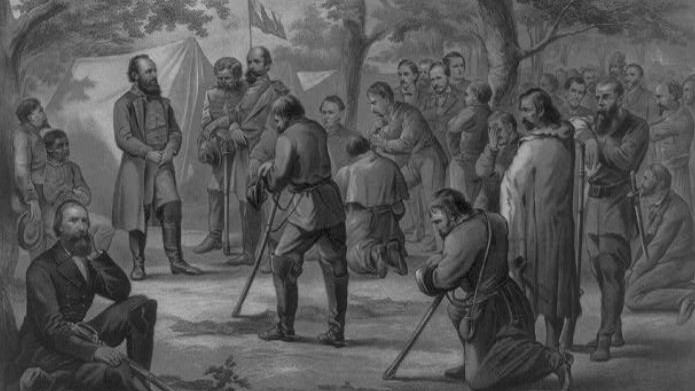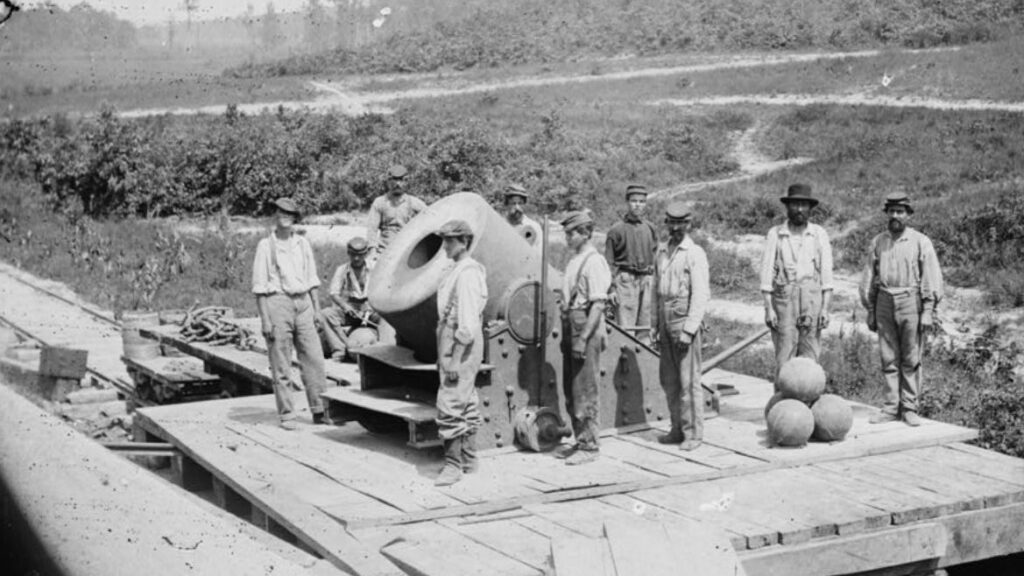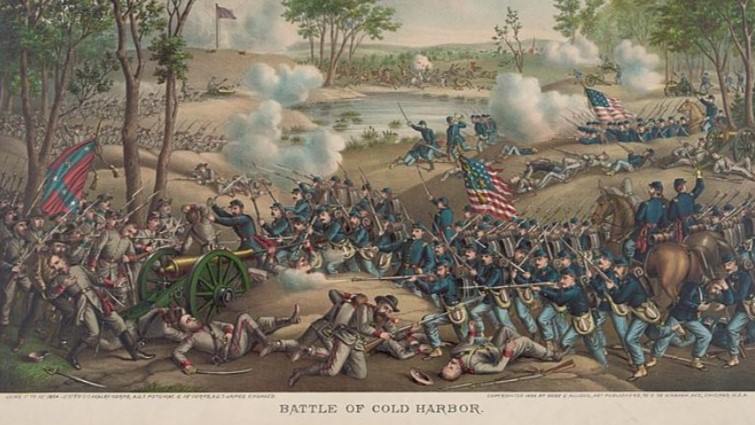How did the North defeat the South? The American Civil War posed a monumental challenge for the Union, forcing them into an offensive war against the seceded Confederate States.
Despite the Union’s advantages in population and industrial capacity, subduing the vast Confederate territory required immense resources and adaptability. After four grueling years, the Union’s evolving military strategy and material superiority ultimately allowed them to defeat the Confederacy.
This article explores the factors that propelled the North to victory, ultimately culminating in General Lee’s surrender at Appomattox.
- 1. The Confederate's Resolve
- 2. Destroying Southern Resources
- 3. The North's Industrial Advantage
- 4. The North Applied Flexible Tactics and Strategy
- 4. Internal Confederate Divisions
- 5. Surrender at Appomattox
- 6. Freedom at Last: Black Americans Embrace Their Rights
- 7. Final Thoughts: Defeat Was Not Inevitable But Became More Likely
- Further Reading
1. The Confederate’s Resolve
The Union’s early assumptions about pro-Union sentiment in the South proved misguided. General Winfield Scott’s ‘Anaconda Plan’ relied on blockading Southern ports while waiting for Union loyalists in Confederate states to push for reunion.
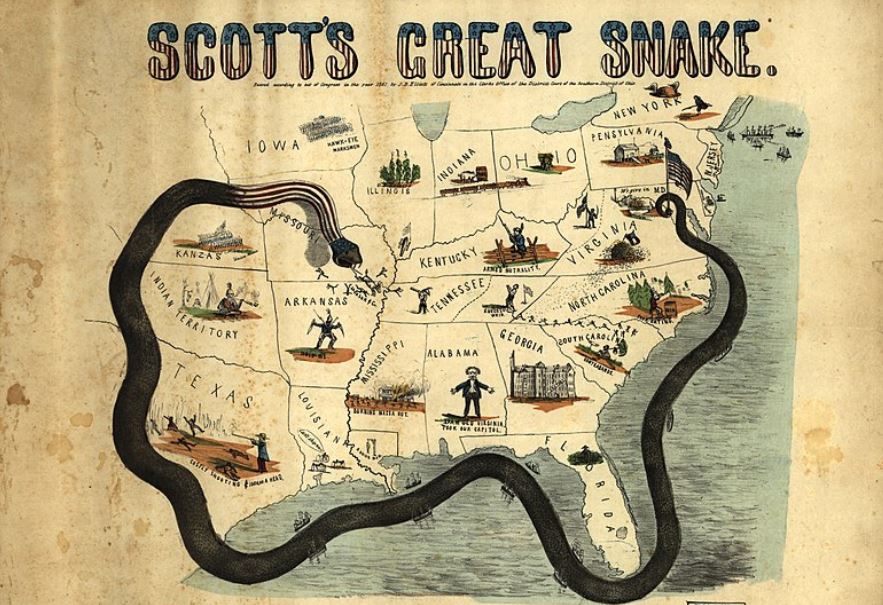
However, most white Southerners staunchly supported the Confederacy despite internal divisions.
The Union grew impatient with Scott’s timetable. This led to Union calls to capture the Confederate capital, Richmond and end the war quickly. But the humiliating Union defeat at First Bull Run showed the dangers of underestimating Confederate resolve.
General McClellan temporarily boosted Union morale with victories out West.
But in Virginia, his slow, cautious Peninsula Campaign allowed the Confederates under Robert E. Lee to reinforce and eject the Union army from the State.
By 1862, it was clear most Southerners backed the Confederacy. The Union shifted to more aggressive strategies like William Tecumseh Sherman’s proposal to exhaust Confederate resources.
2. Destroying Southern Resources
Realizing victory required systematically weakening the South’s ability to wage war, the Union targeted Confederate resources and territory.
Dividing the South by Capturing Vital Cities
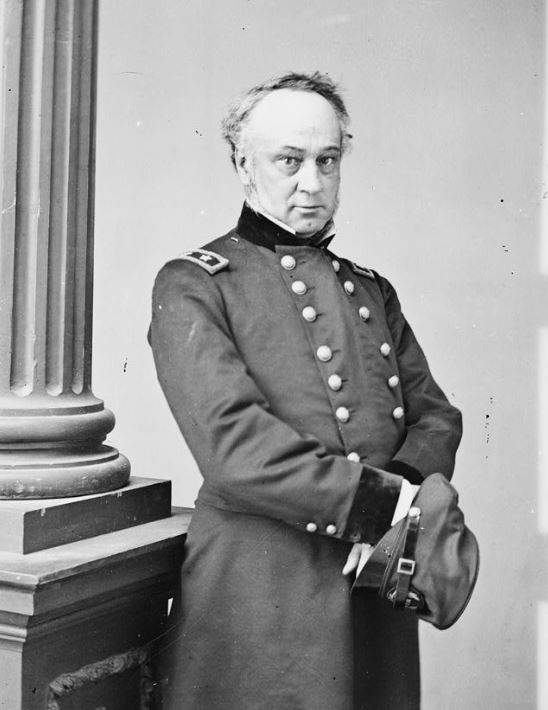
General Henry Halleck devised a plan to fragment the Confederacy by capturing key cities like Vicksburg, Chattanooga, and Knoxville.
Despite setbacks, this strategy helped divide the South.
The Union’s “Hard War”
During the Civil War, the Union implemented various strategies to weaken the Southern Confederacy by targeting its economic and military resources. Some of the tactics used to destroy or disrupt Southern resources included:
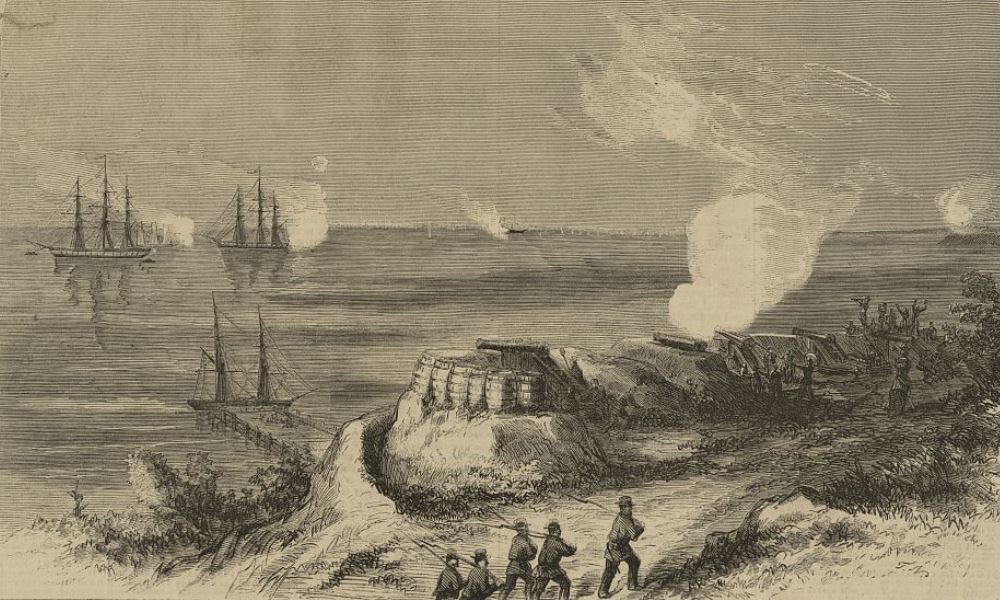
Blockade: The Union Navy established a blockade of Southern ports early in the war. This blockade aimed to prevent the Confederacy from exporting cotton (a key Southern commodity) and importing necessary goods, severely impacting the Southern economy. The blockade limited the Confederacy’s ability to trade and generate revenue.
Control of the Mississippi River: Union forces recognized the strategic importance of the Mississippi River. By gaining control of the river, the Union effectively split the Confederacy into two halves, making it difficult for Southern states to support each other. The capture of key cities along the Mississippi, such as Vicksburg and New Orleans, played a crucial role in this strategy.
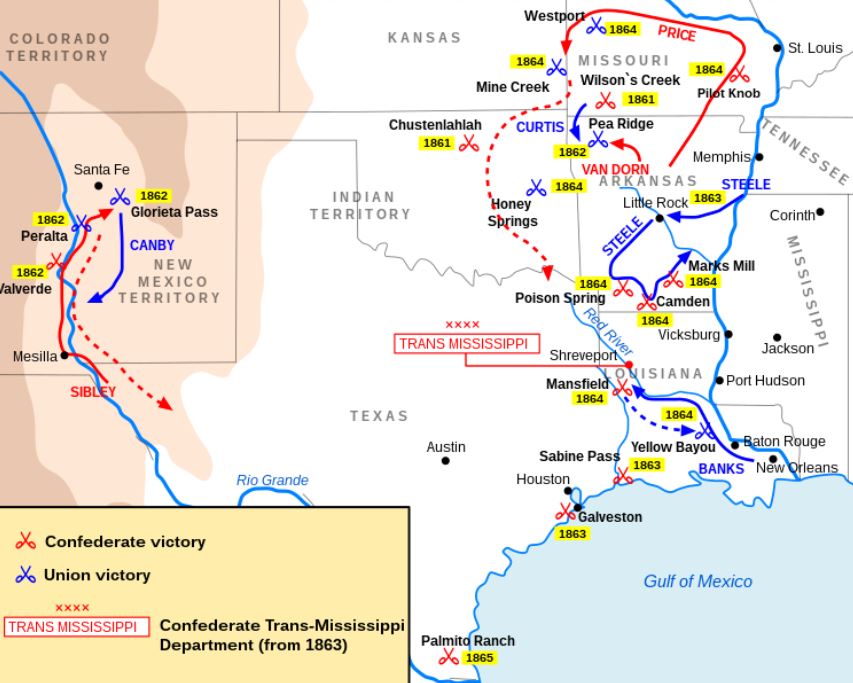
Destruction of Railroads and Infrastructure: Union forces engaged in targeted campaigns to destroy Southern infrastructure, including railroads, bridges, and telegraph lines. This disrupted the transportation of troops and supplies and hindered the South’s ability to move resources efficiently.
Foraging: Union foraging parties stripped Southern farms of livestock, crops, and provisions that might feed Confederate troops. This resulted in starvation conditions for Confederate civilians by 1865.
By 1865, General Lee could scarcely feed his troops. The Union had systematically deprived Confederate armies of critically needed food, horses, and supplies.
Confiscation Acts and Emancipation Proclamation: The Union implemented laws like the Confiscation Acts, allowing for the seizure of property, including slaves, used to support the Confederate war effort. The Emancipation Proclamation, while primarily a moral and political move, also had economic implications by depriving the South of its slave labor force.
Siege Warfare: Union forces engaged in prolonged sieges of key Confederate cities, cutting off their supplies and wearing down the defenders. The siege of cities like Petersburg and Richmond in Virginia played a crucial role in the ultimate defeat of the Confederacy.
Grant’s ten-month Petersburg siege coupled with destruction of farms, railroads, and supplies in the Shenandoah Valley and Georgia left Confederates logistically barren.
These strategies, among others, were part of the Union’s overall approach to achieving victory by weakening the economic and military capabilities of the Confederate states.
By 1865, as Sherman marched through North Carolina, encountering little resistance, the Confederacy lacked the resources to continue fighting.
3. The North’s Industrial Advantage
During the American Civil War, the Union had several strategic advantages over the Confederacy, which contributed significantly to its ultimate victory. Some key resources and advantages of the North included:
Industrial Capacity: The North had a more developed industrial base, with a greater number of factories and manufacturing facilities. This allowed the Union to produce a wide range of war materials, including weapons, ammunition, uniforms, and equipment, on a large scale.
Railroad Infrastructure: The North possessed a superior and extensive railroad system. This network facilitated the rapid movement of troops and supplies, enabling the Union to respond more quickly to strategic needs and reinforce its armies effectively.
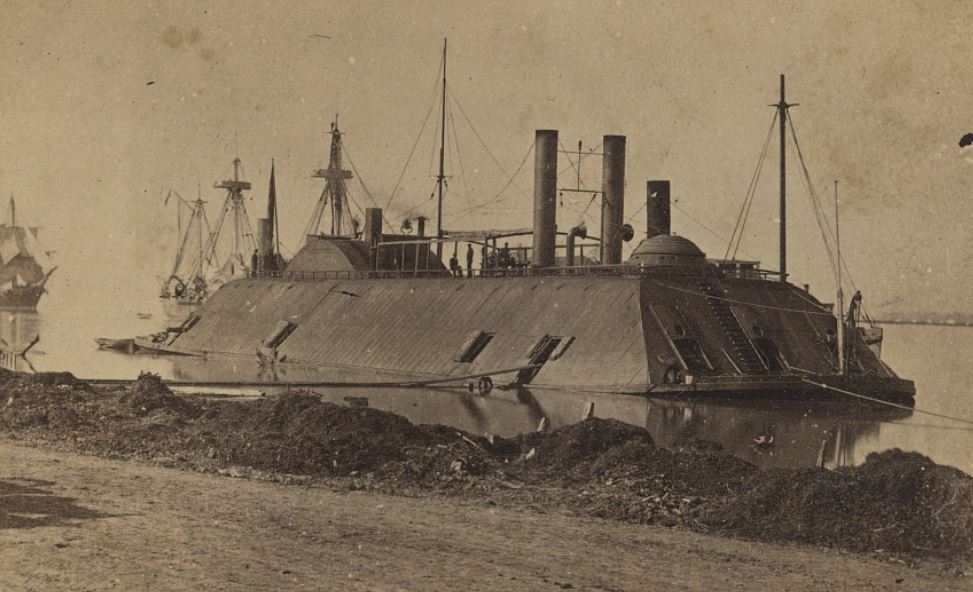
Naval Power: The Union Navy was significantly stronger than the Confederate Navy. The Union’s naval superiority allowed it to establish and maintain blockades along the Southern coastline, restricting Confederate access to international trade and crucial supplies.
Financial Resources: The North had a more stable and diversified economy, including a well-established banking system. This enabled the Union to raise funds through loans and issue a national currency, financing the war effort more effectively than the Confederacy.
Population and Manpower: The North had a larger population than the South. This demographic advantage translated into a larger pool of potential soldiers for the Union Army. The North’s ability to sustain higher levels of manpower throughout the conflict was a critical factor in its military successes.
Agricultural Production: The Northern states were more diverse in terms of agriculture and had a broader range of crops. While the South was heavily dependent on cotton and other cash crops, the North’s agricultural diversity allowed it to maintain a more stable food supply for its population and armies.
Technological Innovation: The North was at the forefront of technological innovation. It embraced new technologies and inventions that enhanced military capabilities, such as repeating rifles, telegraph communication, and ironclad warships.

Political Unity: The political structure of the Union was more stable, with a well-established federal government. In contrast, the Confederacy struggled with issues related to states’ rights and maintaining a centralized authority, which sometimes hindered coordinated efforts.
International Relations: The Union’s diplomatic efforts were more successful in preventing foreign recognition and support for the Confederacy. The North’s commitment to ending slavery also garnered sympathy in some European nations.
These advantages collectively provided the Union with a stronger foundation for waging a prolonged and effective war. While the Civil War was complex and multifaceted, these resources played a crucial role in tipping the balance in favor of the Union.
4. The North Applied Flexible Tactics and Strategy
In the war’s later years, the Union learned to adjust their strategy based on battlefield developments, while the Confederacy clung to rigid defensive tactics.
By 1865, the Union had seized the momentum through methodical execution of adaptive strategies targeting Confederate resources and territory.
Chickamauga Setback:

Battle of Chickamauga (September 1863): Fought in northern Georgia, the Battle of Chickamauga was one of the major engagements in the Western Theater. The Union Army, commanded by General William S. Rosecrans, faced the Confederate Army led by General Braxton Bragg. The battle resulted in a Union defeat, with the Confederates gaining a tactical victory.
Adaptation and Leadership Changes for the North:
After the setback at Chickamauga, there were changes in Union leadership in the Western Theater.
Ulysses S. Grant: Following the defeat at Chickamauga, President Abraham Lincoln appointed Ulysses S. Grant to command the Union forces in the West. He had already gained recognition for his successes in other theaters of the war.
William Tecumseh Sherman: Grant chose William T. Sherman as one of his key subordinates. Sherman would later become a crucial figure in the Western Theater and the overall Union war effort.
Crucial Victories for the North:
Siege of Chattanooga (November 1863): Under Grant’s leadership, Union forces lifted the Confederate siege of Chattanooga. This victory was a turning point that opened up crucial supply lines for the Union and set the stage for future campaigns.
Grant’s Overland Campaign (1864): Grant was later transferred to the Eastern Theater, where he would play a central role in the Union’s overall strategy. However, his move to the East allowed Sherman to take command in the West.

Sherman’s Atlanta Campaign (1864): General Sherman led the Union forces in a successful campaign to capture the strategic city of Atlanta, a critical railroad hub for the Confederacy. This campaign showcased Sherman’s innovative use of tactics and strategies.
March to the Sea (1864): After capturing Atlanta, Sherman embarked on his famous “March to the Sea,” during which Union forces, in a show of total war, moved across Georgia, destroying infrastructure and resources. This campaign further weakened the Southern war effort.
Capture of Savannah (December 1864): Sherman successfully captured Savannah, completing his march and securing another important victory for the Union.
Under the leadership of generals like Grant and Sherman, the Union forces not only recovered from defeats like Chickamauga but went on to achieve crucial victories that played a significant role in the ultimate defeat of the Confederacy.
4. Internal Confederate Divisions
The Confederacy faced several internal divisions that weakened its cohesion and contributed to its overall vulnerability during the American Civil War. Some of the key internal divisions include:
Conscription in the South:
The Confederate government implemented conscription (draft) to bolster its military forces. However, exemptions for slave owners created resentment among poorer white Southerners, as they perceived the draft as favoring the wealthy elite.
This led to increased dissatisfaction and opposition to the war effort. Poor whites, who did not own slaves and might have been less connected to the institution of slavery, were less inclined to support a war that seemed to benefit the planter class.
Impressment:
Confederate impressment involved seizing goods, including food and horses, for military use. The process became coercive and arbitrary, causing frustration among Southern civilians who felt their personal property was being confiscated without fair compensation.
This turned some Southern civilians against the Confederate government, as they experienced direct losses of property and resources. The perception of unfair and arbitrary impressment contributed to a decline in support for the government and the war.
Tax-in-Kind:
The tax-in-kind policy required Southern farmers to provide a portion (10%) of their produce to the Confederate government.
This not only directly affected civilian food supplies but also discouraged agricultural production as farmers faced a significant burden.
The tax-in-kind policy contributed to shortages of food for civilians, exacerbating the already challenging economic conditions. Farmers, burdened by both the demands of the tax-in-kind and the strains of war, had less incentive to increase production, further impacting the Confederate war effort.
These measures taken by the Confederate government, while initially intended to support the war effort, ended up creating divisions and discontent among the Southern population. The perception of inequality in conscription, the arbitrary nature of impressment, and the economic hardships caused by the tax-in-kind policy all contributed to internal strife and weakened the Confederacy’s ability to maintain popular support for the war.
5. Surrender at Appomattox

Robert E. Lee’s April 9, 1865 surrender at Appomattox Court House marked the Confederacy’s death knell while also catalyzing revolutionary change for four million newly freed African Americans.
Isolated and logistically depleted, Lee had little choice but to surrender his tattered Army of Northern Virginia after an intractable ten-month siege.
Already reeling from Sherman’s march, Confederate forces in North Carolina offered negligible resistance as the Union occupied key coastal cities.
6. Freedom at Last: Black Americans Embrace Their Rights
Unlike most white Southerners, Black Americans readily embraced emancipation, exercising their rights despite the hostility and violence they often encountered.
The 13th, 14th, and 15th Amendments codified Black citizenship, equal protection, due process, and suffrage rights, transforming Southern society.
The Civil War’s outcome marked a new day for Black Americans but also sowed the seeds for decades of struggle against the enduring legacy of slavery.
Still, African American resilience in the war’s aftermath demonstrated their determination to finally reap the fruits of citizenship so long denied.
7. Final Thoughts: Defeat Was Not Inevitable But Became More Likely
The South’s defeat was far from predetermined at the outset. However, the Union’s superior resources and evolving military strategy gave them critical advantages as the war dragged on. The Confederacy’s unwillingness to adapt sealed their fate. While not inevitable, Southern defeat became more probable with each passing year of exhausting civil war.
Further Reading
If you enjoyed this article, you may be interested to read more about the American Civil War events, or perhaps read about the bloodiest battles of the Civil War. Read here for more general American history.


